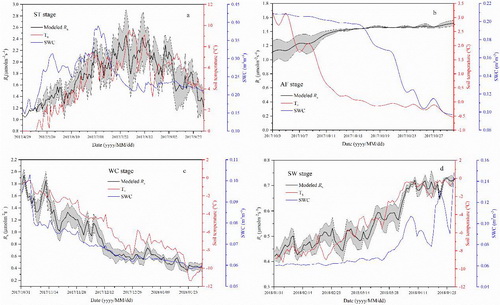Active Layer in Different Freeze-Thaw Stages Modifies Soil Respiration Dynamics
Updatetime:2020-09-22From:
【Enlarge】【Reduce】
Soil respiration (Rs) is a significant source in estimating the terrestrial carbon budget under climate change. It is the second-largest source of carbon emissions to the atmosphere from the terrestrial ecosystem on a global scale.
The Qinghai-Tibet Plateau (QTP) is the widest area distributed with permafrost in the low and middle latitudes. The soil organic carbon pool is as high as 160±87Pg, which plays an important role in global warming.
The active layer, a buffer between permafrost and atmosphere, is more sensitive and responds more quickly to climate change. The freezing and thawing process of the active layer significantly controlled the Rs of the alpine meadow in the permafrost region of the QTP. However, how the freeze-thaw action regulates the carbon emissions is still unclear.
Recently, scientists from the Northwest Institute of Eco-Environment and Resources (NIEER) of Chinese Academy of Sciences (CAS) conducted a two-year continuous in-situ measurement at an alpine meadow permafrost ecosystem in the QTP, divided the freeze–thaw processes into four different stages in a complete freeze–thaw cycle comprising the summer thawing (ST) stage, autumn freezing (AF) stage, winter cooling (WC) stage, and spring warming (SW) stage, and found the freeze-thaw process modified the Rs dynamics differently in different stages.
In this study, scientists determined the dynamics of the Rs during a complete freeze-thaw process of the active layer and compared the Rs patterns among the different freeze-thaw stages and their contribution to total Rs emission in a complete freeze-thaw cycle in this region. Finally, they established a preferable Rs model to accurately predict the soil CO2 emission of each freeze-thaw stage.
The study shows that great changes in freeze-thaw process patterns may trigger more Rs emission as the permafrost degrades and active layer thickens. Besides, scientists found that the soil temperature was the key factor affecting soil respiration regardless of soil water status durin each freeze-thaw stage.
This study has been published in The Cryosphere in an article entitled “Soil respiration of alpine meadow is controlled by freeze–thaw processes of active layer in the permafrost region of the Qinghai–Tibet Plateau”.

Variations in modeled soil respiration (Rs), soil temperature (Ts), and soil water content (SWC) for the four freeze–thaw stages comprising ST (a), AF (b), WC (c), and SW (d) in a complete freeze–thaw cycle (Image by Prof. WANG Junfeng)
Contact:
Qingbai Wu
E-mail: qbwu@lzb.ac.cn
Northwest Institute of Eco-Environment and Resources, Chinese Academy of Sciences, Lanzhou 730000, China.
Appendix




